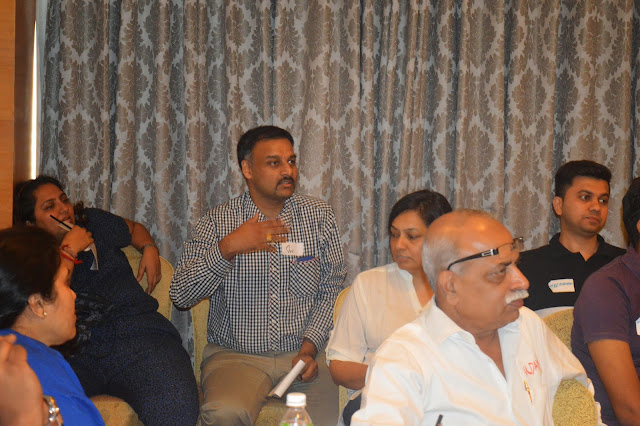Monday, 25 May 2015
Friday, 22 May 2015
Monday, 11 May 2015
Notes from session on Value Based Negotiation written by Mr Vamana Nayak - Learning Over Breakfast - Trainers Forum - Sun, 10th May 2015
Value-Based
Negotiation – A Master Class by Mr. Sadhan Bhattacharya, CPLP
(Highlights of the session held at Thane on
Sunday, 10th May 2015 under the banner of Trainers Forum www.TrainersForum.in
Written by Mr Vamana
Nayak - Manager at Stock Holding Corporation of India Limited
What
is negotiation?
Negotiation is
not a competitive sport. It is not arm-twisting. Negotiation is a series of
conversations aimed at arriving at a mutually beneficial solution. Kids are the
best negotiators with their parents as they do not give up. It is to be
remembered that Price is what you pay and Value is what you perceive.
Features
of not so effective negotiation
1. Focus on price; not on value
2. Unwillingness to have/ continue
relationship
3. Unwillingness to discontinue
relationship
4. Inadequate information/
domain expertise
5. Unrealistic
initial expectations
6. Bad mood of
the parties
7. Inadequate
preparation
8. Compulsion to
balance conflicting/ unrealistic expectations of the internal stakeholders
9. Lack of
clarity on the deliverables
10. Lack of
clarity on the minimum expectations to be met
11. Unwilling to
offer something extra or a different combination say a “silver bullet”
12. Short-term
focus of the parties
12. Unbalanced
power between the parties
13. Lack of
alignment of values
14. Time pressure
to decide
It helps if
features, advantages and benefits (FAB) are offered to elicit a better
response.
Components of Value-based negotiation
1. Value Base
2. You
3. Product/
Service
4. Pricing
5. Your
organization – Brand equity of the organization is helpful.
Effective Versus not so effective negotiation
1. Position taken
2. People
3. Use of options, resources
Wal-Mart is rated as the toughest negotiator with its suppliers. Any
deal with this Company is termed as “Kiss of Death” as the supplier gets badly
squeezed out. Procter and Gamble is one entity which has been able to
adequately respond to this challenge.
Educating and then negotiating could lead to better outcomes.
Position is to be taken after understanding the other party well. Sometimes,
the Power of Weak Signals comes in the way of this.
Positional bargaining is the antithesis of value-based bargaining.
Interest is the root cause and position is the symptom. We need to look beyond
the stated position and understand the underlying interest. When price is the
focus, distinguishing the front-end and back-end margins in the form of offers,
maintenance contracts and long-term discounts could help break the logjam.
Value-based Negotiation – Understanding the model
(PIOC)
1. People: People are to be separated from
issues. In protracted international negotiations, moving to a new place – eg Moving to balcony may help ease the
pressure. The is equivalent of Meta space in NLP. This helps to declutter the
mind.
2. Interests: Focus on interests; not on
positions.
3. Options: Invent multiple options for
action.
4. Criteria: Insist that results be based
on objective criteria.
In case of a
post-rating conversation between the rater and the rate in performance
management discussion, the rater has the option to bring forth compulsions of the
forced distribution based on the bell-shaped curve. He may also focus on future
by discussing the Individual Development Plan (IDP) on a periodic basis.
Value Pursuit:
1. Value
discovery
2. Value creation
3. Value claiming
Win-Win position
is achieved by enlarging the value pie so that both the parties can claim a
larger share of the pie in absolute terms.
A Chinese
value-investor ascribed his success in business by his approach of leaving a
little more to the other party which led to his gaining more as more parties
will be interested in dealing with him in future.
Walk-Away Options:
BATNA – Best Alternative to
Negotiated Agreement. Create alternatives as a fall-back option.
Non-negotiables in negotiation:
1. Ethics
2. Dealing with
terrorists
ZOPA – Zone of Possible Agreement
This is the area
which is the maximum price the buyer is willing to pay and the minimum price at
which the seller is willing to sell. If there is no common area, there is no
ZOPA.
Buyer’s Walk away < Seller’s Walk away
- Develop a list
of options you might take, if no agreement is reached.
- Develop some of
your more promising ideas and convert them into practical alternatives. (Be
creative)
- Select the one
alternative that seems the best.
- Walk away from
the negotiations.
- BATNA
– Enables us to negotiate with confidence.
Assertiveness in negotiation: ‘Positive No’: Y-N-Y
1. Yes – What you
care deeply about yourself (Internally focused)
2. No – Say No with logic/ rationality
3. Yes – Suggest
alternative options (Externally focused)
1. Yes
- Begins on a
positive note
- Stems from
interest and not from position
- Reflects what
is important to you
- Internally
focused
2. No
- Safeguards your
interests
- Based on
rational, objective criteria
- Appreciates
others interests
- Seeks
alternatives with the participation of the other side
3. Yes
- Reaffirms
commitment to pursue the suggested alternatives
- Preserves the
long-term relationship
- Externally
focused
Dealing anger
with an equal or higher degree of anger could be counter-productive.
Resources:
1. The Power of a
Positive No – William Ury
2. Getting to Yes
– Roger Fisher and William Ury
3. www.pon.org
Sunday, 10 May 2015
Subscribe to:
Posts (Atom)






























